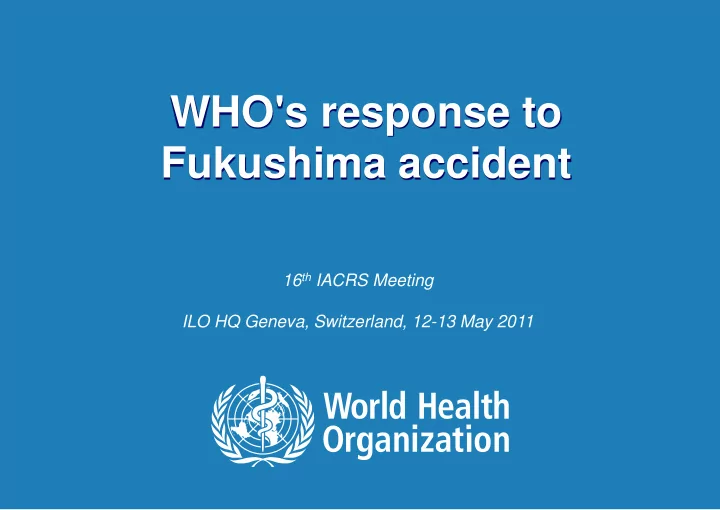

WHO's response to Fukushima accident 16 th IACRS Meeting ILO HQ Geneva, Switzerland, 12-13 May 2011 1 |
In which context Fukushima nuclear accident took place? Maria del Rosario Pérez Department of Public Health and Environment 2 |
Situation Overview Tohoku 9.0 magnitude earthquake 11 March at 05:46 GMT Tsunamis caused the majority of the devastation in coastal areas • Widespread damage to buildings, lifeline infrastructure, communication, transport. • Hospitals affected, health services impacted by loss of electricity and essential supplies. • Robust and timely overall disaster response given the extent of the damage. In addition to this, the tsunami damaged Fukushima nuclear power plant 3 |
Health impact of the overall disaster As of 10 May 14,949 dead; 9,880 still missing; 5279 injured; >117,000 still evacuated. Reported cases of hypothermia, carbon monoxide toxicity, pneumonia, chemical-skin irritation, water & sanitation issues. Psychosocial impact, early need for mental health (MH) support, pediatric MH still a concern. Non-communicable diseases requiring medical assistance and provision of medicines, health care needs for elderly and disable people. Communicable diseases slightly increased, no major outbreaks (gastrointestinal, respiratory). 4 |
WHO's three-level response Headquarters Geneva Western Pacific Regional Office (WPRO, Manila) Kobe Centre 5 |
WHO's role in radiation emergency response WHO Constitution – Function: to act as the directing and co-ordinating authority on international health work – Objective: attainment by all peoples of the highest possible level of health International Conventions on Early Notification and Assistance (1986) and Joint Plan (Rev. 2010) – WHO is responsible to coordinate and arrange for advice or assistance on public health assessment and response, and to provide advice on biological and clinical dosimetry, medical response, longer term medical follow-up, control of food and feed. International Health Regulations (Rev. 2005, into force 2007) 6 |
Radiation Emergency Medical Preparedness and Assistance Network - REMPAN REMPAN is a WHO network of > 40 WHO Collaborating Centres and Liaison Institutions specialized on medical and public health response to radiation emergencies. Directory available at: http://www.who.int/ionizing_radiation/a_e/rempan/en/index.html 7 |
Western Pacific Regional Office (WPRO) WPRO (Manila) Situation Room activated since 11 March; collection of information to monitor the situation; interaction with MHLW and relevant partners. Communication and coordination with WHO Kobe Centre for Health Development and WHO Headquarters (HQ, Geneva). WPRO's role was complemented/reinforced by the key role of Kobe Centre for information gathering nationally. Close interaction with the IHR National Focal Point in Japan & IHR Department (HQ Geneva) to share information with MS through IHR Event Information Site (EIS). Development of Situation Reports, Situation Updates and FAQs. Provision of public health technical advice to MS. 8 |
WHO Headquarters WHO Strategic Health Operations Centre (SHOC) fully activated from the first day. Strong involvement of IHR, PHE/RAD, PHE/ Water & Sanitation, Food Safety, Global Alert and Response, Communications Technical contribution from other relevant programs- Mental Health, Children's Environmental Health, Occupational Health, Nutrition, Maternal Health. In permanent communication with WPRO & Kobe In regular communication with the other Regional Offices. 9 |
WHO's response Continued monitoring of the situation, media flow, following environmental and food monitoring data, seeking for human monitoring data (part, thyroid monitoring in children). Health risk assessment (HRA) to inform public health advice to MS. Mental health support (IASC Guidelines available in Japanese in WHO website http://www.who.int/hac/network/interagency/news/iasc_110423.pdf ) Media communications, individual interviews, press conferences/briefings, communication products (FAQs, technical briefings, factsheets). Collaboration with international partners (nomination of a WHO liaison officer at the IAEA IEC in Vienna, IACRNE meetings, Inter-Agency Task Group on Transport, CTBTO telecons, EU Health Security Committee telecons, WMO expert in Geneva) Regular interaction with experts from REMPAN and WHO Collaborating Centres. Currently interacting with IAEA, UNSCEAR, and FAO for the establishment of an international collaboration on dose assessment (to inform health risk assessment as well as long-term follow-up programs). 10 |
Food Safety WHO worked closely with FAO & joint FAO/IAEA programme to monitor situation and develop technical information products for Member States and the public. WHO receiving updates from Japan through INFOSAN (International Food Safety Authorities Network) for distribution to network members. WHO monitoring media and government websites for food measures being implemented by other countries. – 20 countries plus EU have implemented a variety of control measures on Japanese foods being imported into their countries. – To date, there are very few reports of Japanese foods imported into other countries with radionuclide levels exceeding Codex standards ( Singapore, Hong Kong SAR, China) 11 |
International Health Regulations Event reported by Japan through IHR; situation under constant monitoring for risk assessment – Currently no international spread posing direct health risks; risk of direct radiation effects on other countries considered low. No general restrictions on travel to/from Japan. Screening for radiation of passengers arriving from Japan considered unnecessary at airports or seaports around the world. Provision of public health advice and information on products being traded, monitoring official and unofficial reports of international measures applied to food products. WHO mandated to collect reports from Member States on their measures (including health rationale) if delaying or stopping trade on public health grounds. Ongoing monitoring of travel and trade measures Updated information on Event Information Site (EIS) 12 |
Some preliminary considerations A gap was identified in the inter-sectoral coordination at national level, e.g. health authorities and radiation protection/nuclear safety authorities. IHR lists cross-sectoral cooperation and partnerships as one of the core national capacities for preparedness and response. JPlan 2010 proved to be applicable. In terms of access to technical expertise and knowledge, international networking proved to be very useful (REMPAN, CCs). Psychological impact as a major consequence, particularly in children. Early mental health support to manage acute stress reactions can speed recovery (and can help to prevent long-term consequences such as post-traumatic stress disorder). To put in place appropriate long-term follow up programs to assess health consequences on a scientific basis. 13 |
Thank You
Recommend
More recommend